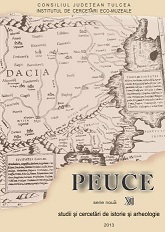Aspecte din viata spirituala a populatiei rurale din zona gurilor Dunarii în pragul noului ev crestin
Aspects of the spiritual life of the rural population at the Mouths of the Danube in the Eve of the new Christian Era
Author(s): Victor Heinrich BaumannSubject(s): Archaeology
Published by: Institutul de Cercetari Eco-Muzeale Tulcea - Institutul de Istorie si Arheologie
Keywords: Roman Period; Dobrudja; Telita; rural habitat; Christianity
Summary/Abstract: Several important archaeological finds reveal the diversity of spiritual life in the rural area of the north Scythian limes, in the transition period to the Late Roman Empire. The most significant spiritual practices concern the continuation of ancient magic-religious manifestations, which, inter alia, claim to account for the “popular” content of Romanian Christianity. We believe and we try to prove that heathen and rustic concepts are not identical, just as the concept of “heathens” cannot define pagani, rustici and gentiles. These assertions of Christian writers are a result of the “Hebrew origin of the Christian lexicon”. The investigations made in the archaeological sites in Northern Dobrudja have revealed the presence of vast rural settlements specific to the late Roman Empire (4th century AD). According to the definition given by Pârvan to this type of settlements, this is a derivation of the Early Roman Empire pagus. We think that the evolution of the indigenous Romanized villages towards the Roman pagus is the result of several factors, such as the pauperization of the rural population after the great crisis in the 3rd century AD, followed by the concentration of property, with all social and economic implications it entailed. It seems that during the Dominate, the name of pagani spreads in the rural area, due to the above-mentioned phenomenon. We can say that the archaeological investigations made in the rural sites from Northern Dobrudja confirm older opinions that the indigenous populations from the old habitat of the Getae-Dacians continues to pay special attention, even in the eve of the new Christian Era, to the magic-religious manifestations. Thus, the ancient cult of the hearth continues at the beginning of the Late Roman Empire. The act of maintaining the hearth in optimal state - proven by the multiple soldering – serves both utilitarian and magic-religious purposes. The best known hypothesis regarding these ritual practices in the rural area underlines their magical purpose, as a result of preserving, from prehistoric times, the solar cult of fire, and, by extension, of the hearth and of the home. These things, considered sacred, were revered with religious sentiment. The discovery of several ritual pits in the rural sites in Northern Dobrudja, with disconnected skeletons, mutilated cadavers deposited directly on the ground, showed another aspect of the ancient magic-religious practices maintained until the Late Roman Empire. In 1984, in the crafts centre on Valea Morilor, dated to the 4th century AD, an artefact of exceptional importance and value was found in the “owner’s home”, fallen next to an altar, together with burnt fragments from handmade pots – jars. The object, made of clay, is the representation of the head, neck and upper torso of an anthropomorphic idol. The technique – manual modelling of coarse clay and plastic execution of the figurine – is from the old Getae-Dacian tradition. The incomplete firing and
Journal: Peuce (Serie Nouă) - Studii şi cercetari de istorie şi arheologie
- Issue Year: XI/2013
- Issue No: 11
- Page Range: 67-100
- Page Count: 34
- Language: Romance (Other)

